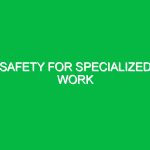In today’s fast-paced work environment, the importance of managing work-related musculoskeletal disorders (MSDs) cannot be overstated. These disorders, which affect muscles, tendons, ligaments, nerves, and the spine, arise from repetitive motions, awkward postures, and excessive force. As organizations strive to cultivate a safe and healthy workplace, understanding the nuances of MSDs and their management is essential. This article delves into the significance of MSD management within the Health, Safety, and Environment (HSE) domain, offering insights, safety precautions, and regulatory frameworks to support effective prevention and treatment strategies.
Understanding Work-Related Musculoskeletal Disorders (MSDs)
Work-related musculoskeletal disorders (MSDs) encompass a range of conditions that affect the musculoskeletal system. According to the World Health Organization (WHO), MSDs are among the leading causes of disability worldwide, accounting for substantial healthcare costs and lost productivity. The relevance of managing these disorders in the HSE context is paramount, as they not only impact employee health and well-being but also influence organizational efficiency and compliance with workplace safety regulations.
Consider the case of a factory worker named Sarah. After years of performing repetitive tasks on the assembly line, she began experiencing chronic pain in her back and wrists. Sarah’s situation is not unique; many employees face similar challenges, highlighting the urgent need for effective MSD management strategies.
Identifying Hazards and Risks Associated with MSDs
To effectively manage MSDs, it is crucial to identify the potential hazards and risks associated with them. These can be broadly categorized into ergonomic, environmental, and organizational factors.
Ergonomic Factors
Ergonomic risks stem from job design and workplace layout. Poor posture, repetitive movements, and inadequate workstation setups can all contribute to the development of MSDs. For instance, improper desk height may lead to wrist strain for office workers who spend hours typing. Similarly, lifting heavy objects without appropriate technique can result in back injuries. According to a study conducted by the National Institute for Occupational Safety and Health (NIOSH), about 33% of all workplace injuries are related to MSDs, underscoring the urgency of addressing ergonomic factors.
Environmental Factors
Environmental hazards include temperature extremes, poor lighting, and inadequate ventilation. A construction worker exposed to cold conditions without proper gear may experience muscle stiffness, increasing the risk of injury during physical tasks. Conversely, insufficient lighting in a warehouse can lead to accidents as employees struggle to see properly, resulting in awkward movements and potential strains.
Organizational Factors
Organizational factors such as work pace, job rotation, and employee training play a significant role in MSD management. High work demands can pressure workers to neglect safe practices, leading to injuries. A compelling example is a logistics company that implemented job rotation among its staff. By changing tasks every few hours, they reduced the prevalence of MSDs, demonstrating how organizational strategies can mitigate risk.
Best Practices for Managing Work-Related Musculoskeletal Disorders (MSDs)
Implementing best practices for managing MSDs is essential for fostering a safer workplace. Here are some actionable strategies that organizations can adopt:
Conduct Ergonomic Assessments
Regular ergonomic assessments are vital for identifying risk factors in the workplace. By evaluating workstations, tasks, and employee feedback, organizations can make necessary adjustments to reduce strain. For example, adjustable chairs, ergonomic keyboards, and proper lifting equipment can significantly decrease the likelihood of MSDs. The American National Standards Institute (ANSI) provides guidelines for ergonomic assessment tools that can assist in this process.
Provide Training and Education
Education is a powerful tool in preventing MSDs. Training employees on proper lifting techniques, ergonomic practices, and the importance of taking breaks can empower them to take control of their health. A manufacturing company that introduced a training program on safe lifting techniques saw a 40% reduction in back injuries over two years, illustrating the impact of comprehensive education.
Encourage Breaks and Task Variation
Encouraging employees to take regular breaks and vary their tasks can help alleviate the strain associated with repetitive work. Simple practices, like stretching or changing positions every hour, can make a significant difference. In a case study involving a call center, the introduction of five-minute breaks every hour resulted in decreased discomfort among employees and improved overall job satisfaction.
Implement Workplace Design Changes
Investing in workplace design can yield substantial benefits. Organizations should focus on creating ergonomic work environments that promote proper posture and movement. For instance, adjustable desks can allow employees to switch between sitting and standing, reducing the risks associated with prolonged sitting. A technology firm that redesigned its workspace to include collaborative areas and ergonomic furniture reported higher productivity levels and lower rates of MSDs.
Safety Precautions for MSD Management
To enhance the effectiveness of MSD management strategies, organizations must adopt specific safety precautions:
Encourage Open Communication
Creating a culture of open communication about health and safety issues is crucial. Employees should feel comfortable reporting discomfort or injuries without fear of retribution. Regular check-ins and feedback sessions can help identify potential problems before they escalate.
Monitor and Evaluate MSD Trends
Organizations should regularly monitor and evaluate trends related to MSDs. By analyzing injury reports and conducting employee surveys, companies can identify high-risk areas and adjust their strategies accordingly. For example, a retail chain that tracked injury data discovered that certain store layouts contributed to higher injury rates, allowing them to implement targeted interventions.
Utilize Technology
Technological advancements can play a role in MSD prevention. Wearable devices that track posture and movement can provide employees with real-time feedback to help them maintain healthy practices. A logistics company that introduced wearable technology reported a significant decrease in musculoskeletal injuries as employees became more aware of their movements.
Regulatory Framework Governing MSD Management
Various regulations and standards govern the management of work-related musculoskeletal disorders (MSDs). These frameworks are designed to ensure workplace safety and health.
Occupational Safety and Health Administration (OSHA)
In the United States, OSHA outlines general duty clauses requiring employers to provide a workplace free from recognized hazards. While OSHA does not have specific regulations solely for MSDs, it emphasizes the importance of ergonomic practices and the need for employers to protect workers from potential injuries.
Guidelines from the National Institute for Occupational Safety and Health (NIOSH)
NIOSH provides guidelines for reducing the risk of MSDs, focusing on ergonomic interventions, training, and hazard assessments. Their recommendations serve as a foundation for organizations seeking to develop effective MSD management programs.
ISO 45001:2018
The ISO 45001:2018 standard focuses on occupational health and safety management systems. It encourages organizations to proactively identify and mitigate risks, including those related to MSDs. Compliance with this standard can enhance workplace safety and demonstrate a commitment to employee health.
Conclusion
Managing work-related musculoskeletal disorders (MSDs) is a critical component of the Health, Safety, and Environment (HSE) domain. By understanding the risks, implementing best practices, and adhering to regulatory guidelines, organizations can create a safer and healthier workplace. Investing in MSD management is not just about compliance; it’s about fostering a culture of well-being that ultimately enhances productivity and employee satisfaction. As more companies recognize the importance of addressing these disorders, they pave the way for a healthier workforce and a more sustainable future.


